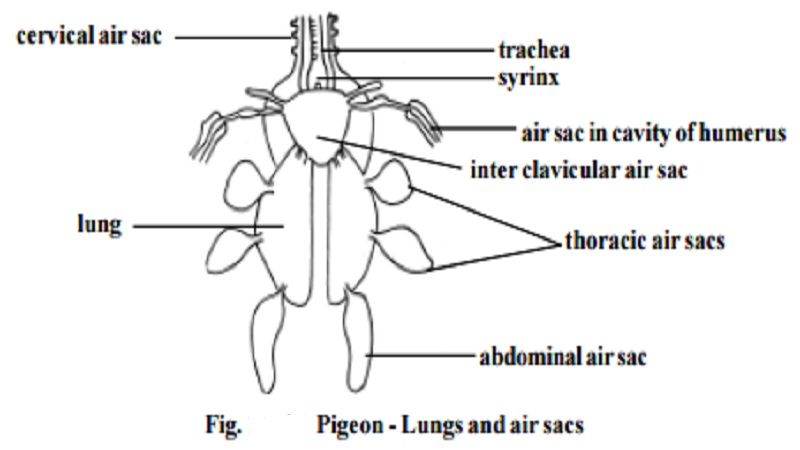Chapter: BIOLOGY (ZOOLOGY) Standard XI first year 11th text book Assignment topics question and answer Explanation Definition
Pigeon - Respiratory System

Pigeon - Respiratory System :-
The flight activity requires a continuous and abundant supply of oxy-gen . Hence, the respiratory system of pigeon is highly developed and well differentiated. The respiratory system consists of external nostrils, glottis, larynx, trachea, bronchus and lungs.
The external nostrils are a pair of slit like apertures occurring at the base of upper beak. They communicate to the pharynx by internal nostrils. A glottislies behind the tongue. It opens into the larynx. The larynx opens into a trachea. The trachea is a long, cylindrical and flexible tube running back- ward through the neck. On entering the thoracic cavity, the trachea expands into a syrinx or voice box. Later it divides into two bronchi, one for each lung. The walls of tracheal and bronchial tubes are supported by a series of closely set cartilagenous rings. Each bronchus enters a bright red lung. The bronchus divides and subdivides into smaller branches, ultimately ending in fine air capillaries. Lungs are solid spongy organs. They do not hang freely in the thoracic cavity but are lodged firmly in the ribs. Some of the branchial tubes pass through the lungs and communicate with the air cavities in the bone. There are nine air sacs. They are a median interclavicular, a pair of cervical, two pairs of thoracic and a pair of abdominal air sacs.
The air sacs help to maintain high body temperatures. They make the body lighter and help in flight.
Mechanism of Respiration :-
In birds the expiration is an active process. The process of inspiration is passive. In a resting bird, the sternum is moved up and down with the help of intercostal and the abdominal muscles.
During flight, the sternum is rendered immovable due to the support of wings, but the body cavity is raised and lowered by the action of wings and by the lowering of the vertebral column.
Pigeon
Sub phylum - Vertebrata
Class - Aves
Order - Columbiformes
Type - Columba livia
Birds are easily recongnised group of vertebrates. In birds every part of the body is modified to suit their aerial mode of life. Birds possess feathers, beak and feet modified in relation to their aerial life.
The Pigeons are flying birds(carinate). They are known both as wild and domesticated forms. The Pigeons are seen both in tropical and temperate zones. About 10 species of Pigeons are found in India. The pigeons fly in flocks and roost together. The domestic pigeons have many varieties, namely panter, fantail and tumblers. They differ in size, colouration and feather ar-rangement. All of them are, however, descendants of the rock pigeon-columba livia.
Related Topics